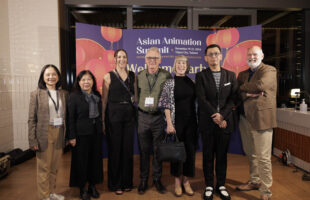the proliferation of content, especially original concepts, can be attributed to various factors, ranging from the continued explosion of satellite TV channels in India or initiatives by government agencies like Singapore’s Media Development Authority (MDA) to promote the exportation of ‘Made-by-Singapore media content’ by encouraging companies to co-produce with leading international partners and actively market their products at overseas trade shows. MDA’s CEO, Dr Christopher Chia, says as Asia plays a bigger role on the world stage – with the recent successful Beijing Olympic Games being a prime example – the region is witnessing greater international interest in Asian programming. According to Todd Miller, executive vice president and managing director, Asia at Sony Pictures Television International, the attention being paid to Asian content and formats in recent years relates to the growing economic and political power of countries such as China and India. As content companies grow their businesses in these countries, they are also exposed to new ideas from such markets. Overall, assessing the situation, Miller feels the market for content these days is truly global. “Good ideas can come from anywhere. Whether it is a US game show like the Power of 10 becoming a big hit in India or a Japanese format like Dragons’ Den becoming a ratings winner for the BBC, the universal appeal of certain formats is undeniable,” says Miller. A Hindi general entertainment channel like NDTV Imagine, launched earlier this year in India, has already licensed several of its prime time shows to markets like Mauritius, South Africa, Pakistan, Italy, South East Asia. “Another set of deals have been closed for markets like Japan, Russia, Poland, Canada. Our content licensing team is focusing on complementing the efforts of our channel distribution team, who have already launched the NDTV Imagine channel in the UK, MENA (Middle East North Africa) region, Fiji and will soon be launching the same in US and South East Asia,” said Gaurav Gandhi, EVP business operations and content syndication, NDTV Imagine. “Indian content has now started crossing the divide whereby not only the markets with large Indian Diaspora are seeking shows and formats from India, but other Central and Western European, African and Latin American countries are picking up a lot of content and then dubbing/subtitling for their local audiences,” says Gandhi, adding that the top markets are still the traditional ones, like North America, UK, Middle East, Pakistan & Malaysia. NDTV Imagine may be striking deals, but when it comes to content acquisition deals, especially in Europe and the US, the feelings are mixed. According to Sameer Rao, SVP – strategic planning and commercial, Star India Pvt Ltd, the company has seen very limited interest for Indian programming concepts and formats in the US/Europe. “There is, however, strong interest in Asia and emerging interest in Latin America. For example, Star India has licenced its Nach Baliye dance show format to Astro for Malaysia and the local language series has been running successfully on Astro Ria for two seasons. There has also been interest in our non-fiction formats from Latin America,” shared Rao. Among others in the region, Caldecott Productions International has not started selling any format programmes yet. Caldecott’s assistant vice president, international Business, Shialey Tan says in terms of new trends, the buyers are spoilt for choice as there is lot of content to choose from. “We are making steady progress in signing deals since our content debuted in the market from October 2006,” said Tan, who added that the top markets seeking Asian content would be France, Middle East, Japan and South Korea. For its part, MDA seems to be reaping rewards of sustained efforts. According to MDA’s Chia, Made-by-Singapore content nowadays can be found entertaining audiences in over 50 countries in Asia, Europe, North America and it’s Nordic region, which testifies to the global appeal. “Over the years, our Singapore companies have acquired a global mindset and more importantly, the capability to create high quality content targeted at and demanded by the international market,” said Chia. He points out factual programming in high definition (HD) format, such as documentaries and lifestyle programmes. For example, Man-Made Marvels, a HD documentary series co-produced by Singapore’s Beach House Pictures and Natural History New Zealand debuted on Discovery Channel across Asia Pacific and has since been sold to the United States, Canada and Hong Kong. It was also broadcast on ZDF, one of Germany’s largest terrestrial broadcasters. Examples of Asian programming that the MDA is marketing at MIPCOM this year include Mad About English, a documentary by Journey Pictures that tracked part of China’s Olympics journey, in particular, its newfound passion for English when it prepared to host the world; FestivAsia – Moondance, a co-production between Singapore’s Big Communications, Korea’s Creo Content and the Korean Broadcasting Institute, which investigates the mystical world of Asia; and, Paradise Asia, a lifestyle programme produced by Xtreme Production and MediaCorp that explores the design and inspiration behind some of Asia’s most sought-after holiday hideaways. Companies like NDTV are doing programme licencing as well as format licensing for broadcast TV. They are also licencing several of their shows for new media and home video distribution. Gandhi points out that new media and newer delivery formats have come into prominence as well. Now both broadcast as well as narrowcast markets have opened up for licencing. In terms of popularity, he said Indian content overseas top three genres would be soaps (drama series), music & dance-based shows, and Bollywood focused shows and events. Star’s Rao says the music and dance-based formats are the most popular followed by the celebrity-hosted format shows. On the nature of deals, he said, “The Astro deal is one example of licensing of an intrinsically strong format with virtually no promotion/marketing. As in the case of most format deals, the buyer was convinced by the core potential of the format but requested for several minor changes to adapt the format to local conditions. Apart from formats, we do sign licensing deals for new and ongoing fiction series with buyers who programmes for South Asian audiences.” On how interaction with programming buyers is evolving, Rao said, “Asia is open to various genres such as dramas, lifestyle, sitcoms, Bollywood-based content, etc. However, regions like Europe, Africa, UK etc. are not so open to Indian dramas, sitcoms. They are more open to Bollywood content due to its global popularity.” In terms of the biggest market, Rao says Asia is the biggest market and more specifically Pakistan. “Even within South Asian audiences, the profile is changing fairly rapidly as younger audiences and more recent immigrants come into the mix. As a result, buyers are seeking more variety in content, including Bollywood based shows, alternative fiction, reality shows and so on,” said Rao. Talking of the potential of the Asian market on the whole, Man Shu Sum, CEO, Mark Burnett Productions Asia, said, “I think we are now at the initial stage though I also see a lot of potential in the region. Hollywood and Europe markets have begun to look for good programming concepts from Asia. The movie industry is a good example to reflect this trend since there are already a few adaptations done. Some of the examples are: The Departed in 2006 was an adaptation of Hong Kong blockbuster Infernal Affairs, The Grudge (Juon) and The Ring (same title) were both adapted from Japan, and 2008 The Eye was based on the 2002 Hong Kong-Thailand-Singapore movie of the same title. I believe such a trend will eventually cross over to the TV industry.” Shu Shum said that companies are beginning to look for newer ideas within Asia, and thereafter adapt them for the international audience. “In my view, Hollywood can be seen as a pioneer in sourcing for new ideas from Asia. Traditionally, people will look for ideas in Japan. Increasingly, they are also exploring possibilities in Korea, Hong Kong and China,” he said. Other than being a avenue for new ideas, the Asian region is also adapting itself by customising its offerings. Caldecott Productions’ Tan says, “As a seller, we meet different buyers with varying needs and we are able to customise our inventory accordingly.” “Our relationship with programme buyers gets closer with each meeting and the concerns with global warming have driven the programming strands for some of them,” added Tan. Referring to a role of a company like SPTI, Miller says his company is in the unique position of being an Asian Hollywood Studio, as the company continues to contribute to the growth of Asian content outside of Asia. “We have distributed a wide range of Asian content all over the world from big blockbuster Chinese movies (Kung Fu Hustle, CJ7) to Japanese animes (Astro Boy, Blood+) to Bollywood films (Saawariya). We have also produced local game shows such as Blackjack Bowling and licensed them to the greater Chinese diaspora. We have even taken a Korean drama from CJ Media we liked called Hyena and are pitching it as a format in Europe. Here in Asia, we see ourselves not just as a distributor of big budget Hollywood fare, but a conduit for the flow of ideas and content from the West to Asia and from Asia to the West,” said Miller.
Ad – Before Content
Related Articles
Sphere Abacus sells true crime feature documentary Murder & Madness: The Cult Conspiracy to Prime Video
Spingo Continues Global Push into the Americas as O4 Media Signs Option Agreements with LA-based 5X Media and Brazilian outfit LaReina Entertainment
Keshet boards Red Alert with producer Lawrence Bende
FIFTH SEASON inks strategic partnership with Front Street Pictures for TV movies slates
Taiwan Hosts Asian Animation Summit for the First Time Bringing Together Major Buyers Netflix and Warner Bros.
Sphere Abacus appoints Toby McCathie as Finance Director







